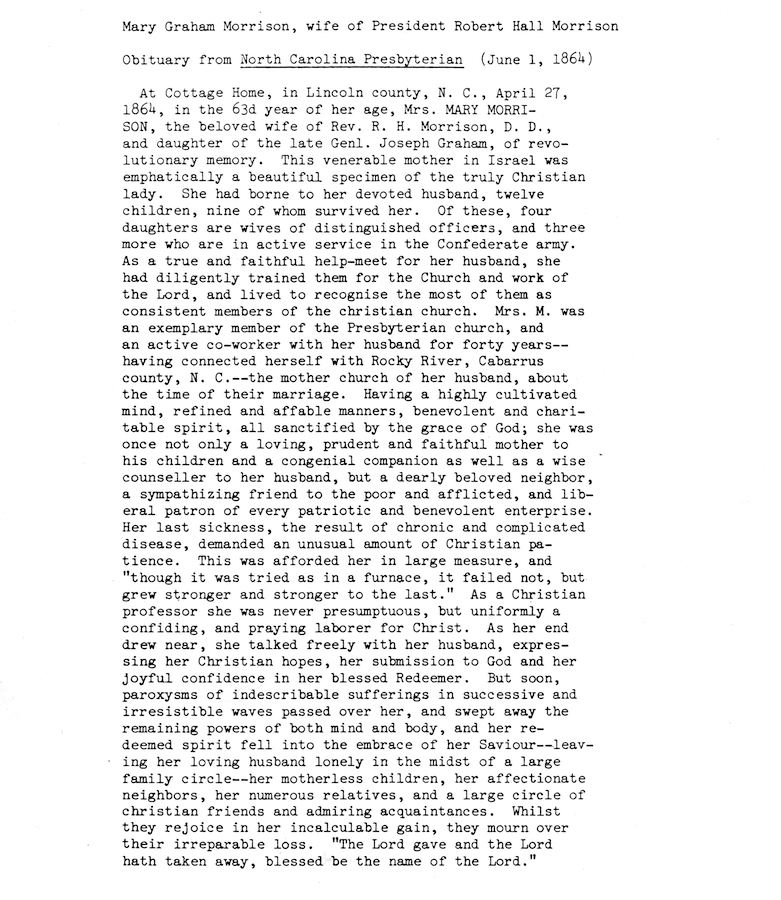L. Collins, L. Walton, C. Clawson, with I. Padalecki
This post, utilizing primarily the oral history of a lesbian Davidson alumni couple, Heather McKee (‘87) and Jane Campbell (‘87), will examine how Christianity and Christian spaces within Davidson College’s history have impacted the experiences of queer students at Davidson. While for some queer students, Davidson’s Christian identity contributed to an isolating environment, others experienced Christianity as a means of companionship and acceptance. We treat the legacy of this tension as a phenomenon of changing experiences over time, chronicling student life from earlier decades up to the current campus culture in 2021 and examining how queer experiences of Christianity at Davidson have both changed and stayed the same across time.
Queer Isolation and Christianity at Davidson in the 1980s
Davidson College has been affiliated with the Presbyterian Church, specifically the Davidson College Presbyterian Church (DCPC), since its founding in 1837. 1“History & Traditions,” Davidson College, Accessed May 10, 2021, https://www.davidson.edu/about/history-traditions.In 1985—while Heather McKee and Jane Campbell were students at Davidson—the denomination declared lesbian and gay full church membership unconstitutional. 2“Timeline of LGBTQIA+ History in the PC(USA): 1970-2019,” Sutori, PC(USA), last modified February 19, 2019, https://www.sutori.com/story/timeline-of-lgbtqia-history-in-the-pc-usa–JiBbvQQSWSTGX8WQcgLG8SY7. Davidson’s affiliation with this church—which, at the time of McKee and Campbell’s time on campus, rejected basic rights for LGBTQ+ individuals—created an unwelcoming culture for queer students at Davidson.

3 Quips and Cranks, Davidson College, 1987.
It was not only through official church policy that Christianity on Davidson’s campus contributed to the isolation of LGBTQ+ students. One undergraduate student, Dee Reynolds, wrote in the 1986 Quips and Cranks yearbook that “the shadow of the church spire reaches far,” referencing the anti-LBGT+ presence and beliefs of many Christian student groups at Davidson.4Dee Reynolds, “Under the Church Spire,” Quips and Cranks, Davidson College, 1986, 69. Throughout the 1980s, several of these anti-LGBTQ+ groups thrived on campus, including the Catholic Campus Ministry, the Fellowship of Christian Athletes, and Intervarsity Campus Fellowship.5Katie Dagenhart, “A Personal Challenge,” Wildcat Handbook, Davidson College, 1984, 49-50.

Davidson’s culture, so influenced by these institutions and groups on its campus, oftentimes did not provide an open and accepting space for queer exploration and identity. In other interviews conducted with Davidson alumni, one encounters a culture in which high-profile administrators and church leaders in the Davidson community were not open about their sexuality, at least to the knowledge of the student population.6Wilson Hardcastle, interview by Laura Collins and Julia Bainum, March 25, 2021. Reflecting on the atmosphere at Davidson, McKee stated:
As far as I know, there was no support for LGBTQ students. And that’s really sad, I mean, it’s terrible, I struggled […] there were classmates that we had and dear peer folks who left Davidson. Because they couldn’t get support, and, you know, it just was such a toxic atmosphere.7Jane Campbell and Heather McKee, interview by Lucy Walton and Courtney Clawson, March 12, 2021.
Queer Exploration and the Church
Stopping there, however, does not tell the full story. Scholars of queer history have recognized how churches historically have fostered queer exploration and identity, even as church teachings and procedures said otherwise. Social events, church groups, choirs, and retreats all provided the opportunity for church members to gather and spend significant time with members of the same gender.8John Howard, Men Like That: A Southern Queer History (Chicago: University of Chicago Press, 1997), 52-54 Additionally, as scholars have pointed out, church buildings, as they remained frequently unoccupied and unlocked during the weekdays, also provided the physical space to engage in queer sexual activity.9John Howard, Men Like That: A Southern Queer History (Chicago: University of Chicago Press, 1997), 52.
In more recent decades, churches in Davidson have served as spaces that fostered queer love and identity. Such fostering was not underground—it was established by official church policy. In fact, McKee and Campbell had their service of blessing at DCPC, becoming the first lesbian couple to be married there in 2013.10Campbell and McKee, interview by Walton and Clawson, 2021; Ariana Howard, “Wildcat Weddings: A Look at Davidson Marriages,” Davidsonian, November 20, 2019. This was important to the couple due to their close ties with the Presbyterian church and the role that their faith has played in their identity formation. Indeed, McKee, who has a Master of Divinity and is an ordained elder, noted that: “when I really came out was at seminary.”11Campbell and McKee, interview by Walton and Clawson, 2021; Ariana Howard, “Wildcat Weddings: A Look at Davidson Marriages,” Davidsonian, November 20, 2019. This complicates the sometimes-oversimplified notion that Christianity and queerness are intrinsically in conflict.

Campbell and McKee’s choice to be married in a Christian service was not only impactful for them. Sharing a memory about their friendship with an older Davidson alum, Bill Benson, Campbell recalls: “We had at our service a blessing, and as everything was getting ready, I looked out into the sanctuary and just about lost it because I was wearing my Navy service dress white uniform and, lo and behold, in was walking Bill Benson in his World War Two era service dress uniform.”13Campbell and McKee, interview by Walton and Clawson, 2021; Ariana Howard, “Wildcat Weddings: A Look at Davidson Marriages,” Davidsonian, November 20, 2019. She went on to explain that after Benson passed, she was approached by his children, who communicated to her that:
We firmly believe that dad got to live these extra months because you guys changed it and you guys gave him an appreciation and understanding […] Our father didn’t live a life where he would have accepted your relationship. But it was- it was you guys, […] it was two Davidson alumni, and it was a Davidson alum who served in his navy. 14 Campbell and McKee, interview by Walton and Clawson, 2021.
Making Space for Queerness and Christianity at Davidson
McKee and Campbell’s marriage at DCPC serves as a powerful symbol for the politics of belonging and visibility. Conducting this ceremony in the Davidson context created a public demonstration of a lesbian couple taking up religious and social space on Davidson’s campus to celebrate their love and companionship. Further, their relationship with Benson demonstrates how such visibility fosters a culture of acceptance. This speaks to the capacity for influence that Davidson could yield when making the campus and its Christian spaces safe and affirming environments for queer students to celebrate their identities openly and visibly.
Regardless, there is still much to be done to make Davidson a safe space for queer students. When asked what Davidson students and administrators could do to make it a better place, McKee and Campbell both cited the presence anti-LGBTQ+ fundamentalist Christian groups at the school as a continued barrier for queer students, emphasizing the importance of inclusive religious dialogue on campus.15Campbell and McKee, interview by Walton and Clawson, 2021.15 Heather noted, “There are religious organizations on the Davidson campus now that do not foreground their theological beliefs, when it comes to LGBTQ people and do—I think—some pretty, you know, disingenuous recruiting to get folks involved and in their groups.”16Campbell and McKee, interview by Walton and Clawson, 2021.
Thus, the complicated history of queerness and Christianity at Davidson continues to unfold, revealing a relationship between queerness in which Christianity, sin, and sexuality are much more nuanced than any one size fits all conception. Heather McKee and Jane Campbell’s marriage and ongoing leadership roles point to the possibilities for radical change in the politics of belonging on Davidson College’s campus and in Christian spaces more broadly, and demonstrate the importance of oral history towards more deeply understanding and potentially altering these historically-contingent relationships between sexuality and Christianity at Davidson College.













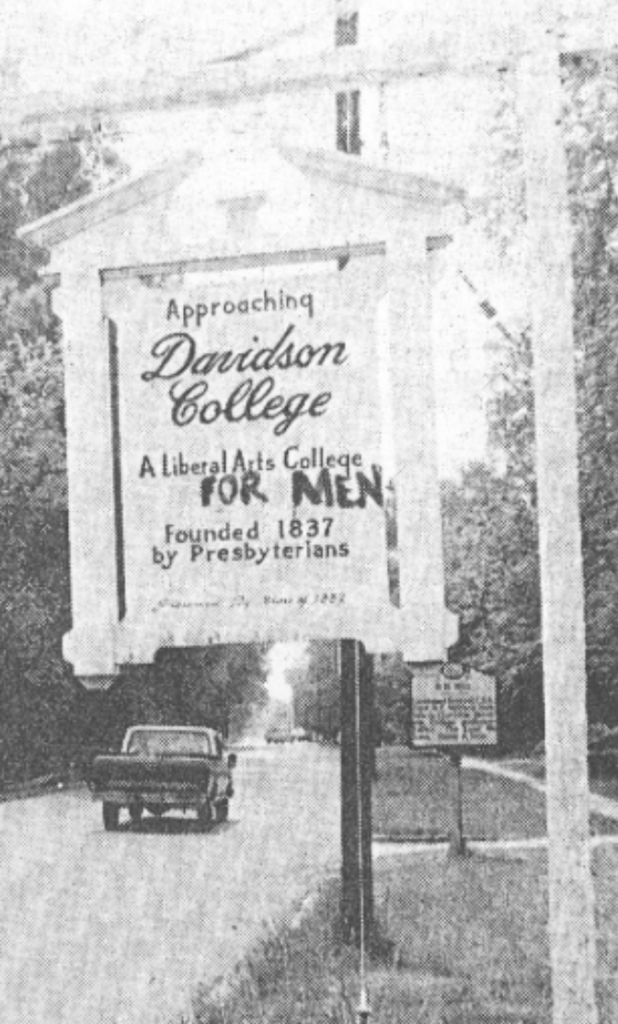
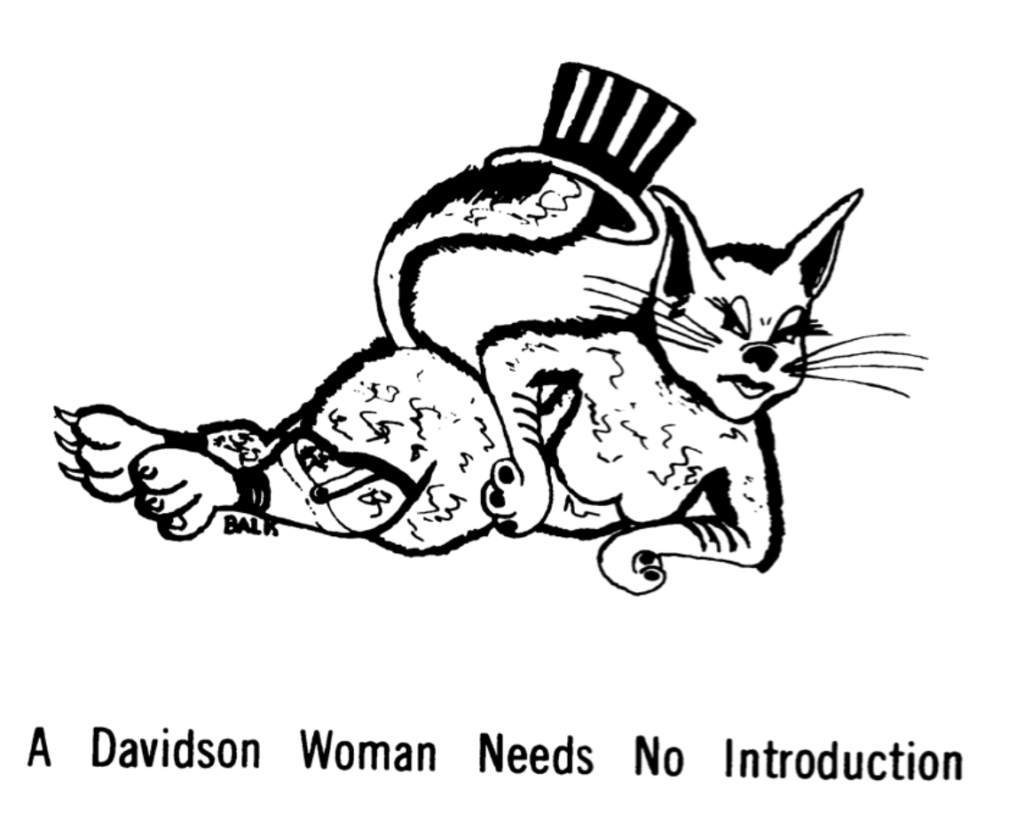












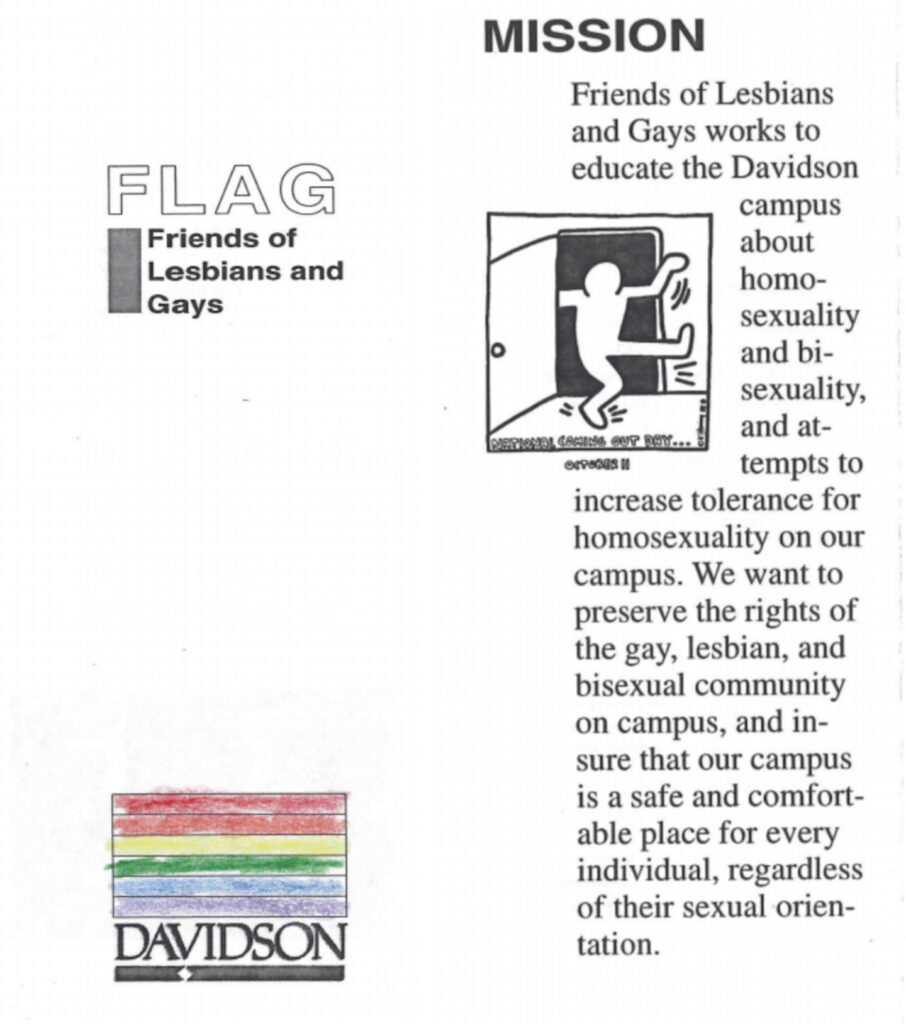






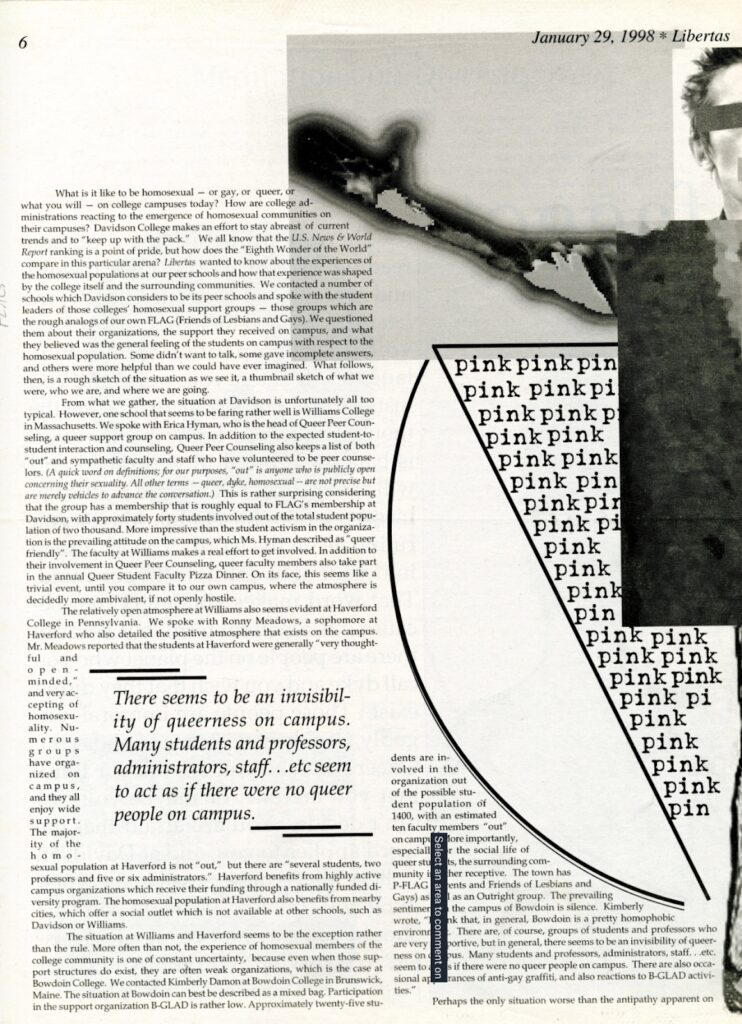




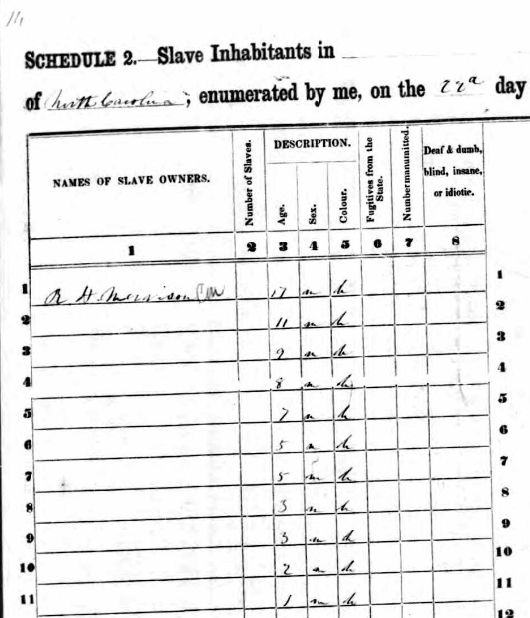 <
<
 <
<